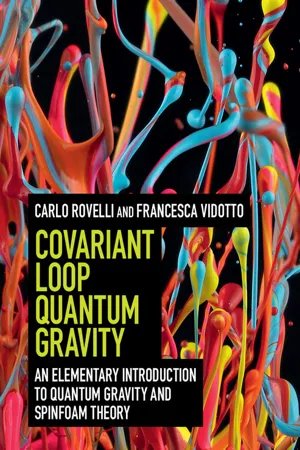
Covariant Loop Quantum Gravity
An Elementary Introduction to Quantum Gravity and Spinfoam Theory
- English
- PDF
- Available on iOS & Android
Covariant Loop Quantum Gravity
An Elementary Introduction to Quantum Gravity and Spinfoam Theory
About this book
Quantum gravity is among the most fascinating problems in physics. It modifies our understanding of time, space and matter. The recent development of the loop approach has allowed us to explore domains ranging from black hole thermodynamics to the early Universe. This book provides readers with a simple introduction to loop quantum gravity, centred on its covariant approach. It focuses on the physical and conceptual aspects of the problem and includes the background material needed to enter this lively domain of research, making it ideal for researchers and graduate students. Topics covered include quanta of space; classical and quantum physics without time; tetrad formalism; Holst action; lattice QCD; Regge calculus; ADM and Ashtekar variables; Ponzano-Regge and Turaev-Viro amplitudes; kinematics and dynamics of 4D Lorentzian quantum gravity; spectrum of area and volume; coherent states; classical limit; matter couplings; graviton propagator; spinfoam cosmology and black hole thermodynamics.
Frequently asked questions
- Essential is ideal for learners and professionals who enjoy exploring a wide range of subjects. Access the Essential Library with 800,000+ trusted titles and best-sellers across business, personal growth, and the humanities. Includes unlimited reading time and Standard Read Aloud voice.
- Complete: Perfect for advanced learners and researchers needing full, unrestricted access. Unlock 1.4M+ books across hundreds of subjects, including academic and specialized titles. The Complete Plan also includes advanced features like Premium Read Aloud and Research Assistant.
Please note we cannot support devices running on iOS 13 and Android 7 or earlier. Learn more about using the app.
Information
Table of contents
- Cover
- Half-title
- Title-page
- Copyright information
- Dedication
- Table of contents
- Preface
- Part I: Foundations
- Part II: Three-Dimensional Theory
- Part III: The Real World
- Part IV: Physical Applications
- References
- Index